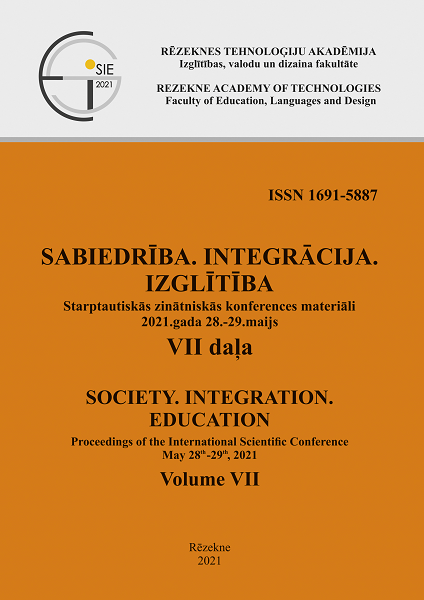RELEVANCE OF INDICATORS OF SOCIAL EMOTIONAL HEALTH IN DIFFERENT SAMPLES OF ADOLESCENCE
DOI:
https://doi.org/10.17770/sie2021vol7.6309Keywords:
Socio-emotional health, teenagers, youth, city, town, nationalities, genderAbstract
The aim of this research was to determine whether there are statistically relevant differences in Michael J. Furlong's concept of socio-emotional health with meta construct Covitality (SEV factor) between teenage and youth selections, gender, and nationalities in different schools.
The participants of the research were 593 respondents from Latvia, aged 11-19 years. Out of the total selection of participants (N=593) there were 318 teens (M=13.01, SD=.84), of them 151 boys and 167 girls; the other group of 274 young people (M=15.85, SD = 1.02), consisted of 132 males and 142 females. To measure the positive aspects of the mental health, A Socio-emotional Health Survey was used (Social Emotional Health Survey – Secondary, SEHS-S, Furlong, You, Renshaw, & O’Malley; 2014; adapted in Latvian by Kņaze, 2017).
There were raised 6 questions in the beginning of the research. Results showed higher results for girls on the scale Belief in Others (its substructure Peer Support) and on the scale Emotional Competence (its substructure Empathy), compared to the selection of boys.
The results on the scale Engaged living were statistically higher for teens compared to the selection of the youth. Teens also had higher statistical results of Co-vitality compared to the youth. However, the selection of youth showed statistically higher results in the Emotion Regulation (the substructure of Emotional Competence) compared to the selection of teens.
The respondents from city schools showed statistically higher results on the scale Belief in Self, Engaged Living and Co-vitality compared to students from town schools.
The Regression Analysis highlights the importance of the school environment in Co-vitality, which explains the 3% variance of the socio-emotional health.
References
Belkin, G., Wissow, L., Lund, C., Aber, L., & Bhutta, Z. (2017). Converging on child mental health – toward shared global action for child development. PMC PubMed Central, 4 (20). Retrieved from https://www.ncbi.nlm.nih.gov/pmc/articles/PMC5719480/
Boman, P., Mergler, A., & Pennell, D. (2017). The Effects of Covitality on Well-Being and Depression in Australian High School Adolescents, 3 (2-15). https://doi.org/10.21767/2471-9854.100046
Bratton, S. C., Landreth, G. L., Kellam, T., & Blackard, T. (2019). Child–Teacher Relationship Training as a Head Start Early Mental Health Intervention for Children Exhibiting Disruptive Behavior. PsycARTICLES, 28 (1). Retrieved from http://datubazes.lanet.lv:3537/ehost/detail/detail
Damon, E.J, Greenberg, M., & Crowly, M. (2015). Early Social-Emotional Functioning and Public Health: The Relationship Between Kindergarten Social Competence and Future Wellness. American Journal of Public Health, 105 (11). Retrieved from https://ajph.aphapublications.org/doi/full/10.2105/AJPH.2015.302630
Furlong, M.J., Dowdy, E., Moore, S.A. & Bertone, A. (2015). Validation of the social and emotional health survey for five sociocultural groups: multi group invariance and latent mean analyses. Psychology in the Schools, 52(4). https://doi.org/10.1002/pits.21828
Furlong, M.J., Dowdy, E., Moore, S.A., & Bertone, A. (2018). Assessment of complete social emotional wellness: An international school psychology perspective. In C. Hatzichristou & B. Nastasi (Eds.), Handbook of school psychology in a global context. Dordrecht, Netherlands: Springer.
Furlong, M.J., Renshaw, T.L., Dowdy, E., & Rebelez, J. (2014). Covitality: A synergistic conception of youths' mental health. In M. J. Furlong, R. Gilman, & E. S. Huebner (Eds.), Handbook of Positive Psychology in the Schools (2nd ed.). New York, NY: Routledge/Taylor & Francis.
Guo, C., Tomson, G., Keller, C., & Söderqvist, F. (2018). Prevalence and correlates of positive mental health in Chinese adolescents. BMC Public Health, 18(1), 1-11. https://doi.org/10.1186/s12889-018-5133-2
Meeus, W., Van de Schoot, R., Hawk, S. T., Hale, W. W., & Branje, S. (2016). Direct aggression and generalized anxiety in adolescence: heterogeneity in development and intra-individual change. Journal of Youth and Adolescence, 45(2), 361-375. https://doi.org/10.1007/s10964-015-0388-8
Patton, G. C., Sawyer, S. M., Santelli, J. S., Ross, D. A., Afifi, R., Allen, N. B., ... & Viner, R. M. (2016). Our future: a Lancet commission on adolescent health and wellbeing. The Lancet, 387(10036), 2423-2478. https://doi.org/10.1016/S0140-6736(16)00579-1
Piquers, J. A., Garcia-Olcina, M., Rivera-Riquelme, M., Rodriguez-Jimenez, T., Martinez-Gonzalez, A. E., & Cuijpers, P. (2017). DetectaWeb Project: Study protocol of a web-based detection of mental health of children and adolescents. BMJ Open, 7(10), e017218. https://doi.org/10.1136/bmjopen-2017-017218
Renshaw, T.R., Furlong, M.J., Dowdy, E., & Rebelez, J. (2014). Covitality: A synergistic conception of youths' mental health. In M. J. Furlong, R. Gilman, & E. S. Huebner (Eds.), Handbook of Positive Psychology in the Schools (2nd ed.). New York, NY: Routledge/Taylor & Francis. Retrieved from https://www.researchgate.net/publication/263619629
Renshaw, T.R., Furlong, M.J., Dowdy, E., & Rebelez, J. (2018). Social Emotional Health Survey-Secondary – 2015 edition. Santa Barbara, CA: University of California Santa Barbara, International Center for School Based Youth Development.
Snowden, M. B., Steinman, L. E., Carlson, W. L., Mochan, K. N., Abraido-Lanza, A. F., Bryant, L. L., ... & Anderson, L. A. (2015). Effect of physical activity, social support, and skills training on late-life emotional health: a systematic literature review and implications for public health research. Frontiers in Public Health, 2, 213. http://doi.org/10.3389/fpubh.2014.00213
Thomson, K. C., Guhn, M., Richardson, C. G., Ark, T. K., & Shoveller, J. (2017). Profiles of children's social–emotional health at school entry and associated income, gender and language inequalities: a cross-sectional population-based study in British Columbia, Canada. BMJ Open, 7(7), e015353. https://doi.org/10.1136/bmjopen-2016-015353
Timofējeva, T. (2016). Theoretical and practical research of M. J. Furlong concept of socio-emotional health in adolescents and young adults. LU data base. Retrieved from https://dspace.lu.lv/dspace/handle/7/43679
Walker, D. M., Bell, M. R., Flores, C., Gulley, J. M., Willing, J., & Paul, M. J. (2017). Adolescence and reward: making sense of neural and behavioral changes amid the chaos. Journal of Neuroscience, 37(45), 10855-10866. https://doi.org/10.1523/JNEUROSCI.1834-17.2017
Wang, D., Hagedorn, A. D., McLaughlin, D. K., & Bray, B. C. (2018). Change and Stability of Emotional Health of Rural Pennsylvania Youth During High School. The Journal of Rural Health, 34(3), 322-332. https://doi.org/10.1111/jrh.12296






